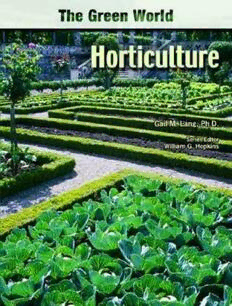
Horticulture PDF
Preview Horticulture
Horticulture Ethnobotany Forestry Horticulture Photosynthesis and Respiration Plant Biotechnology Plant Cells and Tissues Plant Development Plant Diversity Plant Ecology Plant Genetics Plant Nutrition Horticulture Gail M. Lang, Ph.d. Series Editor William G. Hopkins Professor Emeritus of Biology university of Western ontario Dedicated to my husband Jonathan, and to our parents Ron, Jane, and Annie who nurtured a love for things green and growing Horticulture Copyright © 2007 by Infobase Publishing All rights reserved. No part of this book may be reproduced or utilized in any form or by any means, electronic or mechanical, including photocopying, recording, or by any infor- mation storage or retrieval systems, without permission in writing from the publisher. For information contact: Chelsea House An imprint of Infobase Publishing 132 West 31st Street New York NY 10001 ISBN-10: 0-7910-8961-4 ISBN-13: 978-0-7910-8961-3 Library of Congress Cataloging-in-Publication Data Lang, Gail M. Horticulture / Gail M. Lang. p. cm. — (The Green world) Includes bibliographical references and index. ISBN 0-7910-8961-4 (hardcover) 1. Horticulture—Juvenile literature. I. Title. II. Series. SB102.L36 2006 635—dc22 2006025585 Chelsea House books are available at special discounts when purchased in bulk quantities for businesses, associations, institutions, or sales promotions. Please call our Special Sales Department in New York at (212) 967-8800 or (800) 322-8755. You can find Chelsea House on the World Wide Web at http://www.chelseahouse.com Text and cover design by Keith Trego and Ben Peterson Printed in the United States of America Bang HP 10 9 8 7 6 5 4 3 2 1 This book is printed on acid-free paper. All links and Web addresses were checked and verified to be correct at the time of pub- lication. Because of the dynamic nature of the Web, some addresses and links may have changed since publication and may no longer be valid. 1 10,000 Years of Horticulture 2 2 Classification of Plants 16 3 Propagation and Breeding 30 4 Cultural Requirements 46 5 Ecology and Pest Management 62 6 Commercial Horticulture 78 7 Garden Design 90 8 Horticultural Professions 102 Glossary 108 Bibliography 115 Further Reading 118 Index 120 By William G. Hopkins “Have you thanked a green plant today?” reads a popular bumper sticker. Indeed, we should thank green plants for providing the food we eat, fiber for the clothing we wear, wood for building our houses, and the oxygen we breathe. Without plants, humans and other animals simply could not exist. Psycholo- gists tell us that plants also provide a sense of well-being and peace of mind, which is why we preserve forested parks in our cities, surround our homes with gardens, and install plants and flowers in our homes and workplaces. Gifts of flowers are the most popular way to acknowledge weddings, funerals, and other events of passage. Gardening is one of the fastest-growing hobbies in North America and the production of ornamental plants contributes billions of dollars annually to the economy. Human history has been strongly influenced by plants. The rise of agri- culture in the Fertile Crescent of Mesopotamia brought previously scattered hunter-gatherers together into villages. Ever since, the availability of land and water for cultivating plants has been a major factor in determining the location of human settlements. World exploration and discovery was driven by the search for herbs and spices. The cultivation of New World crops—sugar, vii viii IntroductIon cotton, and tobacco—was responsible for the introduction of slavery to America, the human and social consequences of which are still with us. The push westward by English colonists into the rich lands of the Ohio River valley in the mid-1700s was driven by the need to increase corn production and was a factor in precipitating the French and Indian War. The Irish potato famine in 1847 set in motion a wave of migration, mostly to North America, that would reduce the population of Ireland by half over the next 50 years. As a young university instructor directing biology tutorials in a classroom that looked out over a wooded area, I would ask each group of students to look out the window and tell me what they saw. More often than not, the question would be met with a blank, questioning look. Plants are so much a part of our environment and the fabric of our everyday lives that they rarely register in our conscious thought. Yet today, faced with disappearing rain forests, exploding population growth, urban sprawl, and concerns about climate change, the produc- tive capacity of global agricultural and forestry ecosystems is put under increasing pressure. Understanding plants is even more essential as we attempt to build a sustainable environment for the future. The Green World series opens doors to the world of plants. The series describes what plants are, what plants do, and where plants fit in the overall scheme of things. Horticulture shows us how humans have learned to cultivate plants for use as ornamentals and to produce fruits and vegetables. We also learn the impact of horticultural methods on the environment and the importance of developing sustainable meth- ods for future food production and protection of the environment.
